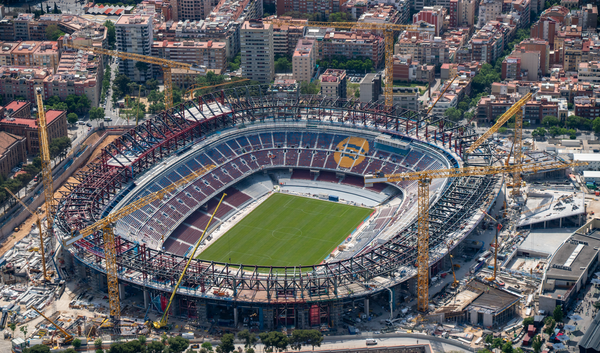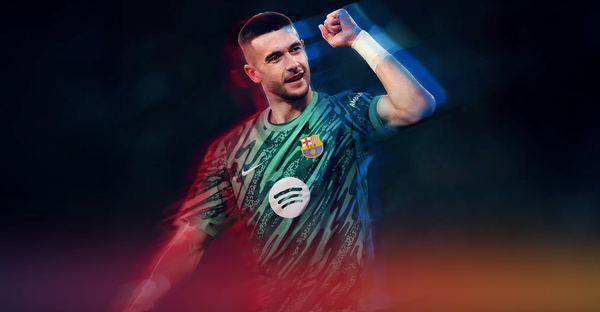Athletic Club opposition analysis: Xavi vs Valverde Round 2
Athletic Club’s defensive structure is still solid but a couple of squeaky wheels alongside some mechanical flaws could cause trouble for Valverde’s men when they welcome the Catalan giants at San Mames this Sunday.

On Sunday evening, Ernesto Valverde’s Athletic Club will host Barcelona at San Mames. In their previous encounter earlier in the season, Xavi’s side demolished the Basques 4:0 at the Camp Nou. But that was Barça at their best; Barça with the likes of Pedri, Robert Lewandowski and Ousmane Dembele, none of whom will feature in the reverse fixture. Add to that the absence of Ronald Araujo and this might indeed pose a challenge to the Catalans.
So what can we expect from Athletic Club? How do they set up, how do they like to attack and defend? And how do they stack up against Barcelona?
Let’s find out.
Team overview
Athletic Club are currently 9th in LaLiga, trailing 29 points behind Barcelona in what seems like a terrible mismatch. On paper at least. In the last five games, they’ve drawn one, lost two and won two, signalling a slight struggle in picking up form. However, in spite of all of that, Valverde has managed to coach a very structured and organised team; a team that’s best described as intense, compact, aggressive, pacey and more generally speaking, well-balanced.
I say well-balanced because they don’t necessarily top the metrics in any given category but are formidable in almost all of them. Their defence is sturdy and tight, allowing the third-lowest expected goals in LaLiga this season in addition to having the third-lowest shots against, fourth-most shots blocked, fourth-most interceptions, sixth-best challenge intensity and fifth-lowest PPDA (passes allowed per defensive action).
On the other side of the coin, they are the team with the third-most shots in the league, second-most offsides, fourth-most corners and fourth-most key passes. In many of these metrics, Athletic Club are near the very top of LaLiga. But there is one big flaw they suffer from - conversion. This season, they’ve managed to score 30 goals from 32.51 xG, tallying 0.1 xG per shot (penalties excluded). In essence, lately, they’ve been a team that does a lot of things right bar the final touches.
On Sunday, Valverde will also face his former team without Unai Simon, Ander Herrera and crucially, Oihan Sancet, the player that makes things happen for Athletic Club. But even with these absences, they are a formidable side.
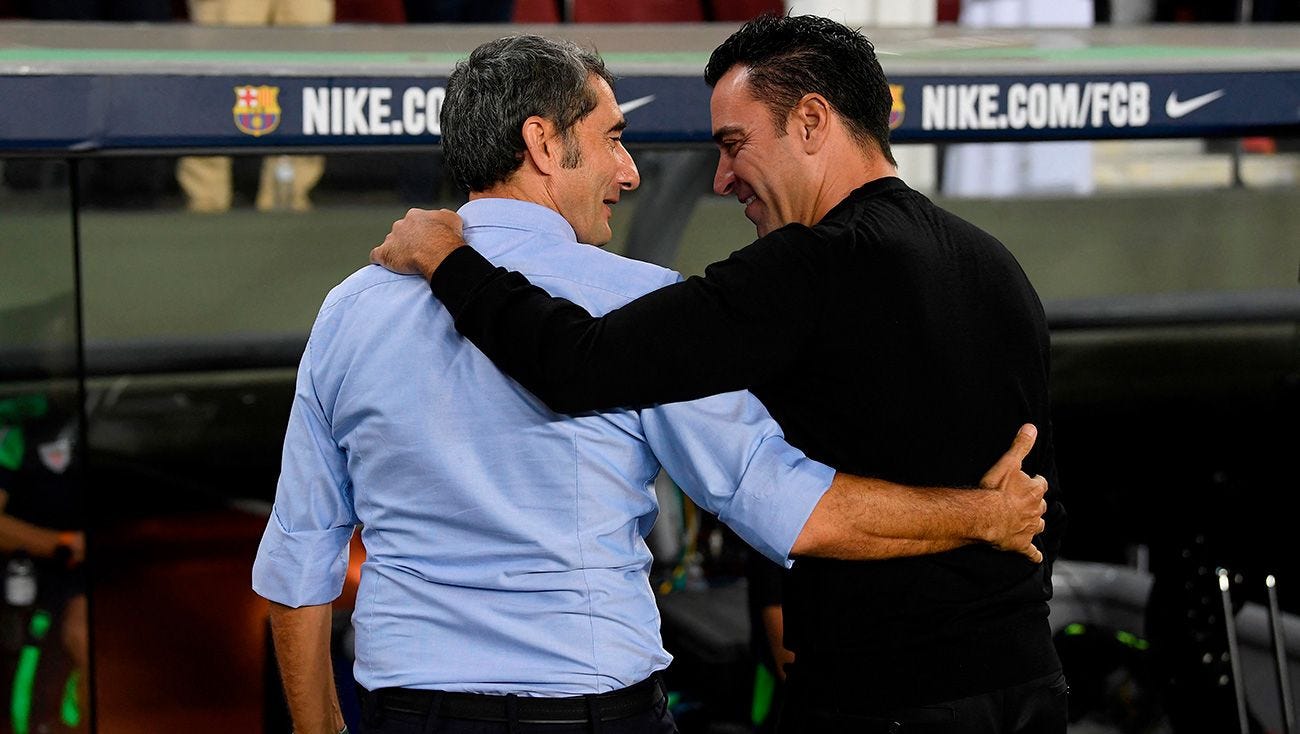
Athletic Club on the ball
Valverde is often seen as a pragmatic coach. While that may be true to a certain extent, he is also a coach with a clear approach, an idea and a structure in mind. This season, Athletic Club have remained largely loyal to their 4-2-3-1 formation, deploying it in 78% of all games in LaLiga. The formation often shifts and morphs, sometimes looking more akin to a more traditional 4-3-3 and its 3-4-3 variation but as a general rule of thumb, this is what we can expect on Sunday too.
This was their lineup in the 4:0 defeat to Barcelona earlier in the season:
Simon – Berchiche, Inigo, Alvarez, De Marcos – Herrera, Vesga – Berenguer, Zarraga, Nico W. – Inaki W.
Simon and Herrera will be absent this time around, as will Sancet, which will undoubtedly have a big impact on their performance. Instead of the goalie, we can expect Julen Agirrezabala in between the sticks, Garcia instead of the injured Herrera and Muniain to slot into the starting XI in Sancet’s absence.
The lineup may look something like this:
Agirrezabala - Berchiche, Inigo, Alvarez, De Marcos - Vesga, Garcia - Berenguer, Muniain, Nico W. - Inaki W.
It’s interesting that Martinez and Alvarez haven’t started as a CB tandem a lot lately, even though that may seem the way to go for Valverde. We can, for that reason, expect someone like Dani Vivian to displace Alvarez while Inigo almost certainly gets to start. Statistically, however, the pairing of Inigo and Alvarez makes the most sense as they are both defensively solid while still offering output on the ball.
Alvarez has among the most passes in the team (and passes into the final third) as well as the most interceptions, most aerial duels in their penalty area, most blocked shots and most long passes alongside Simon. Inigo is the most successful defensive dueler in the team, boasts the most long passes per 90 minutes (complimentary to their style) and is the team’s third-best progressive passer behind Yuri Berhciche and Alvarez himself.
The centre-backs are a very important part of Valvede’s jigsaw but Athletic Club are a team that nurses a style between possession-based and counter-attacking football. In essence, they’re likely to dominate ‘lesser’ opposition while happily relying on transitions against opponents who wrestle the ball away from them. This season, they’ve recorded a high of 63.67% possession and a low of 37.2%, which interestingly came against Barcelona themselves. This rounds up to 51.06% on average this season. So what can we expect from them in possession?
The 4-2-3-1 on paper will morph depending on the opposition’s press. Barcelona are a team that loves to press high so they will aim to suffocate Athletic Club’s CBs. In that case, they like to be very direct and quick in their delivery. Often we’ll see them progress play in two or three passes at most, not unlike Xavi’s Barcelona themselves.
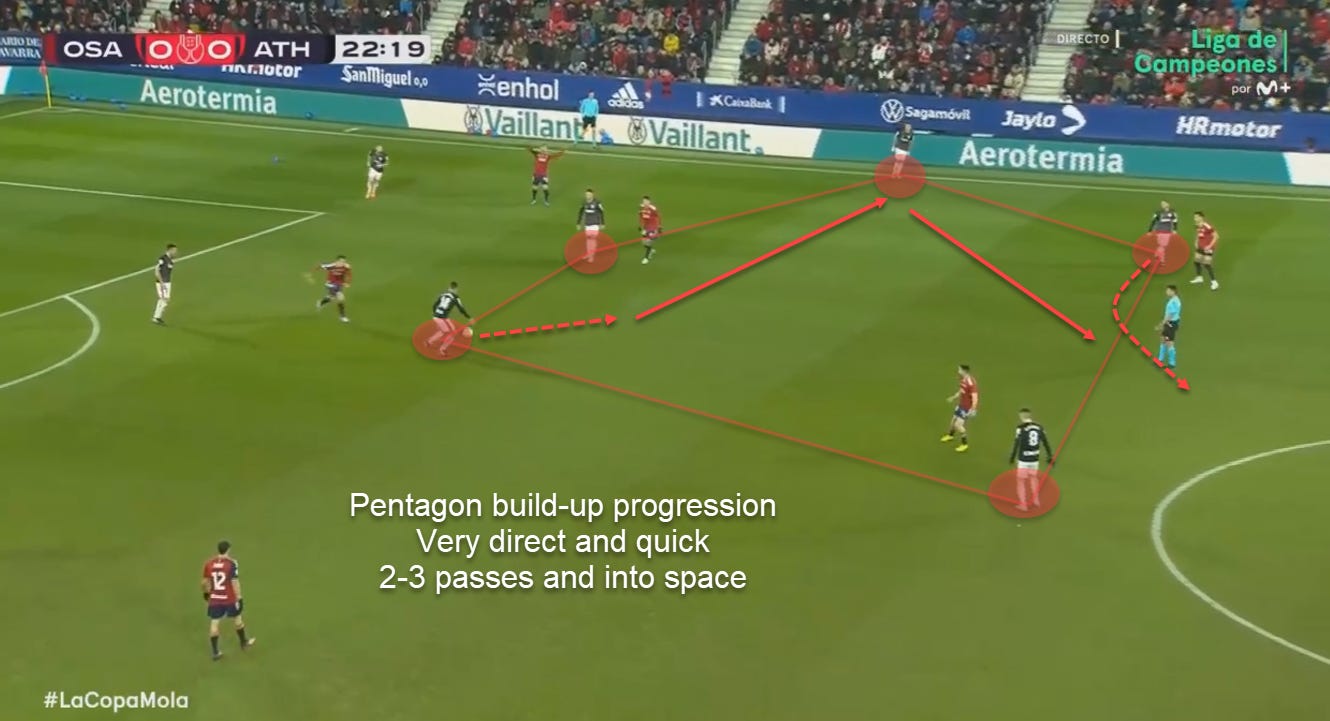
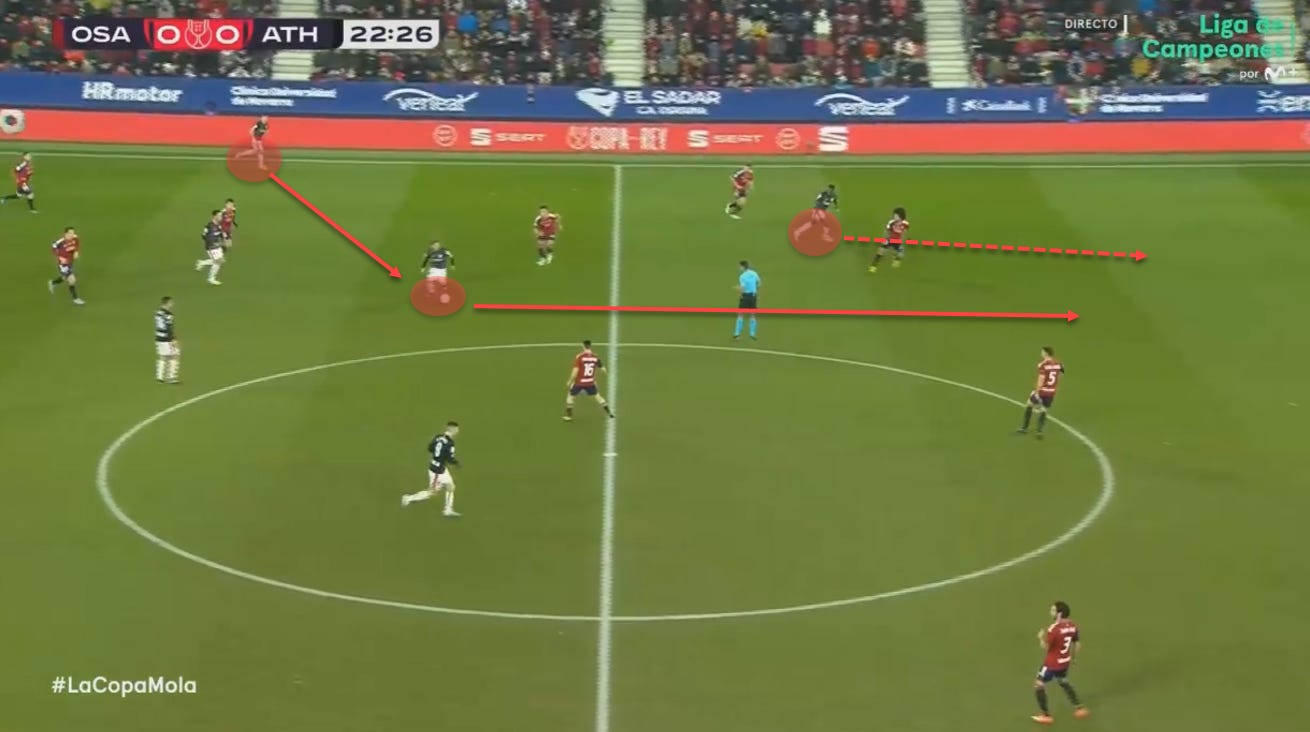
In this sequence, we can see them forming a pentagon to help progress play against a high press. The double-pivot will be assisted by another midfielder higher up, the ball-side full-back and the dropping winger, especially on the left side of the pitch. Once they progress, they will be very quick to look for outlets in the likes of the Williams brothers, Berenguer or the full-backs Berchiche or De Marcos.
Everything about Athletic Club is about exploiting space and with Barcelona’s high-line almost a guarantee, this will undoubtedly be their greatest weapon. Another common pattern against heavy pressure is morphing into a three-man backline. Usually, it’s Garcia dropping between the centre-backs or a full-back staying in line with the two central defenders to form this structure.
Even though they are a side that’s used to relying on transitions, they can create and use superiorities quite well.
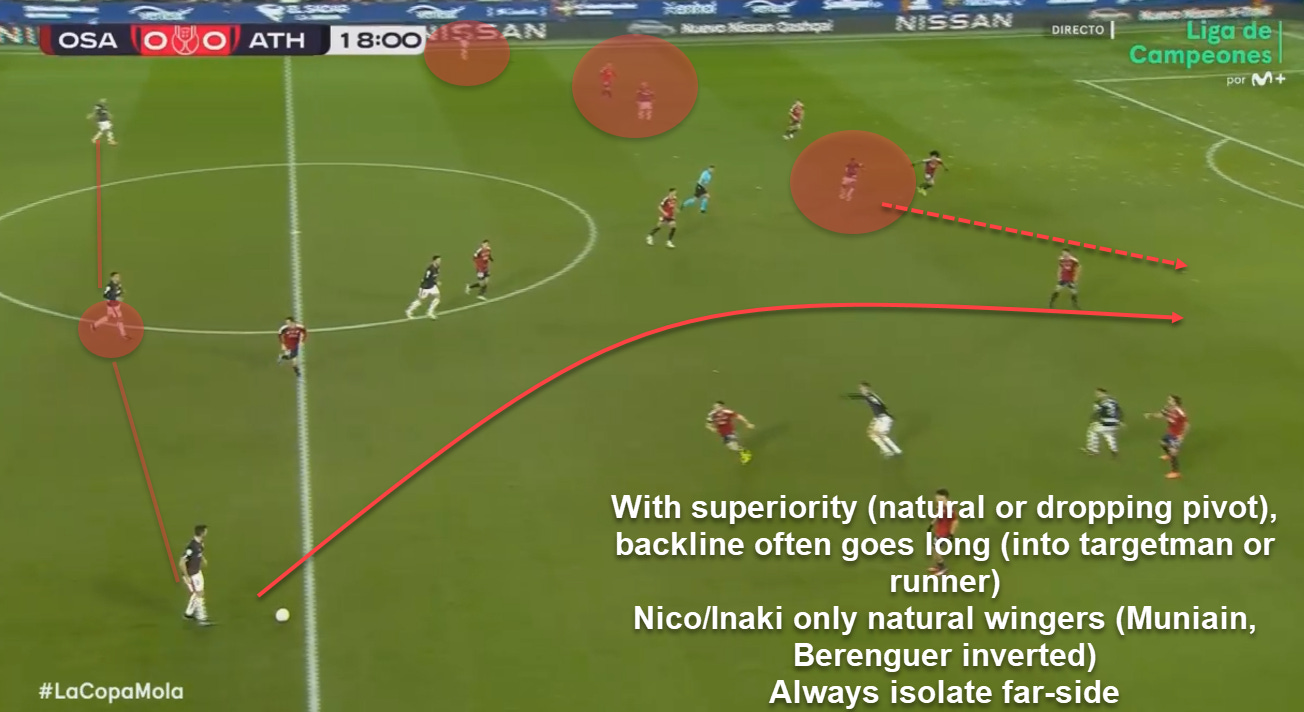
However, even in instances where they’ve achieved it, going long and direct is always the preferred route. Here, they have numerical superiority in the first line, which gives the backline time on the ball. Instead of a combination play, they opt to find runners in the channels, like above.
This isn’t only the case against high pressing, however. Even when they face a mid 4-4-2 block, for example, they will look to cut through it rather than systematically dismantle it. Against a two-man pressing unit in the first line, they may choose to drop a pivot deeper but if progression is possible, they will look for it through the centre-backs and into the midfielders.
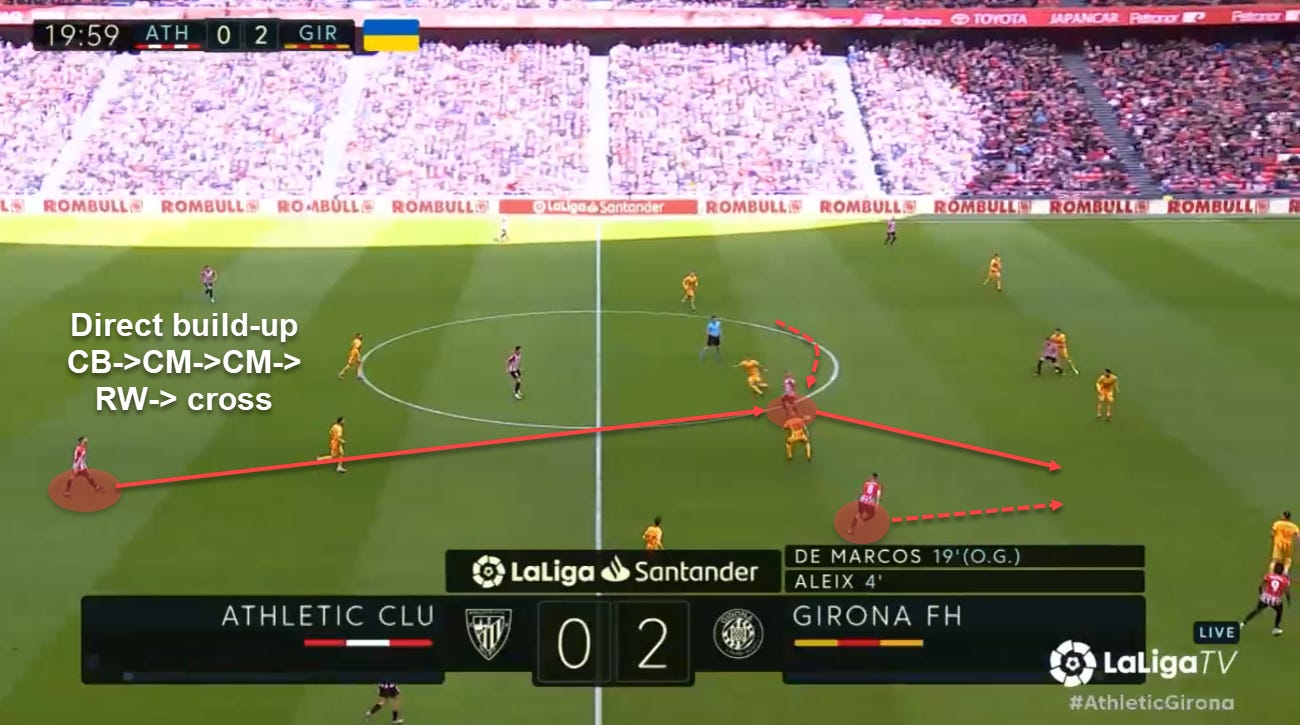
The fluid movement of the two interiors is crucial here as Muniain curves his run to dismark himself while Sancet pushes forward to receive in the half-space. Once that’s been done, he can easily link up with the winger who then looks for crosses and cutbacks into the box.
Another common pattern that’s been prevalent in all of the examples so far is the overload to isolate and go long tactic. Athletic Club’s centre-backs will often deploy diagonal switches to access the far-sided winger or full-back who they work hard to isolate. Generally, this will be done from left to right or, if there’s a chance to access the right winger from the same side, that too will be an option.
The full-backs are quite important in their progression as the near-sided full-back will participate in creating the triangle/square/pentagon and the far-sided one will try and overlap the winger.
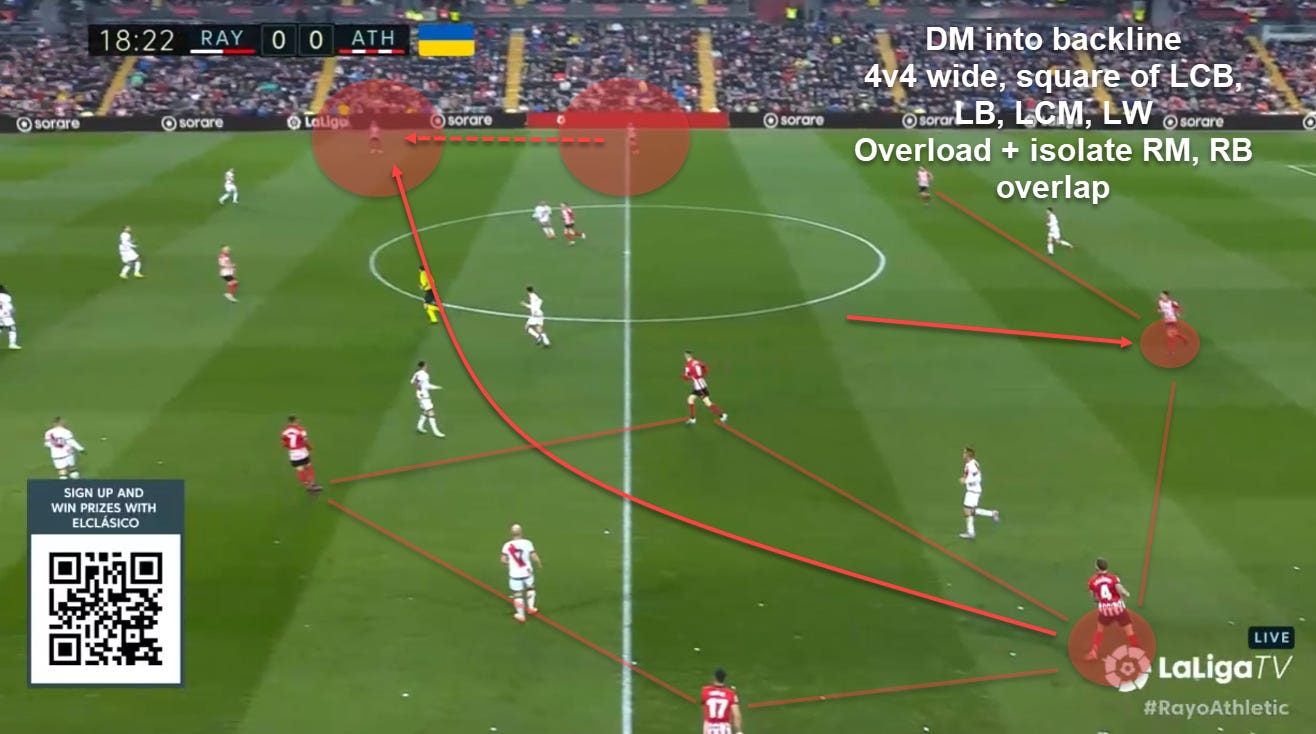
Here, too, we see the pivot dropping into the backline so the centre-backs get more time on the ball. Once they are free, they’ll look for outlets almost immediately. In this sequence, we can also see the square forming and the overload to isolate tactic in full motion once again. The near-sided full-back is assisting the build-up while the far-sided one attacks in an asymmetric shape.
While Athletic Club’s only real wide wingers are the Williams brothers, they have a lot of runners in the team. Both full-backs and Berenguer (mostly LW) can be outlets when needed even though the latter tends to cut in after initially holding width, and the interiors, especially the right one, are extremely aggressive off the ball.
This mechanism is key in understanding Athletic Club as a team. Runners are the hub of this squad and more often than not, the penetration will happen through the half-space.

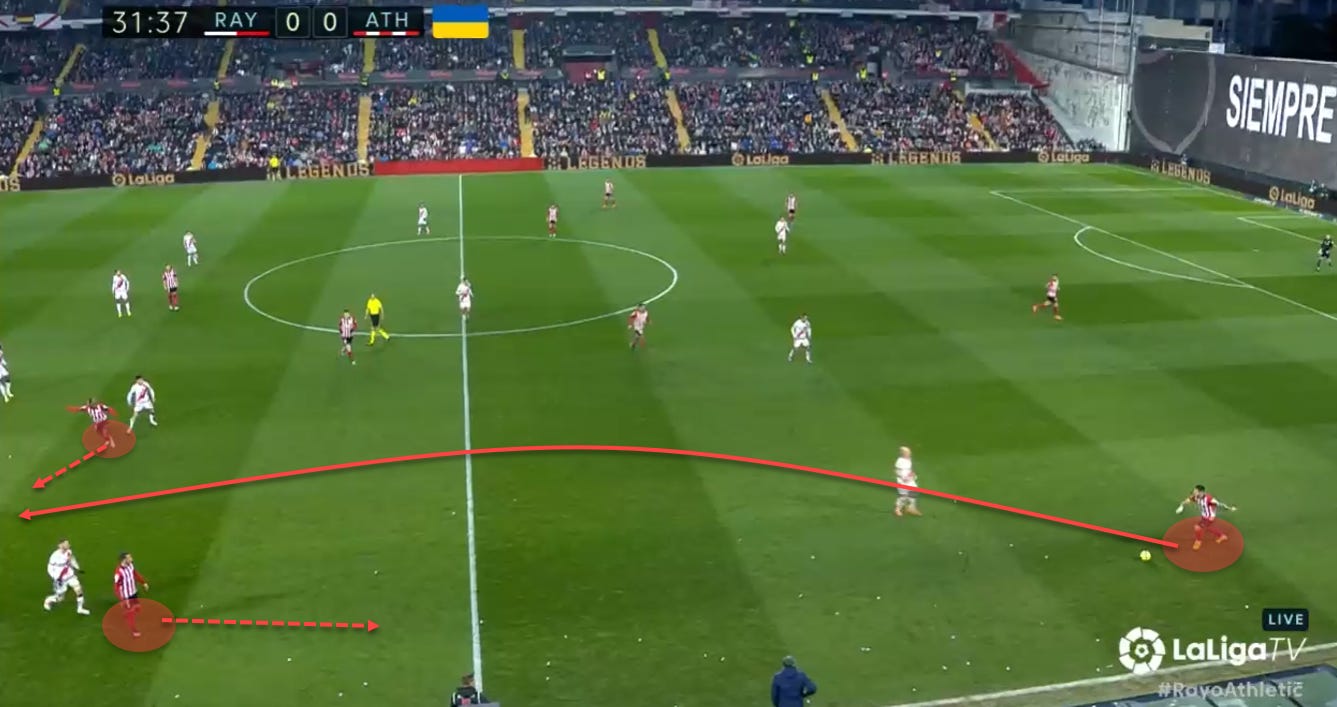
If a diagonal switch isn’t possible, Athletic Club will find runners on their ball-side of the pitch, just like in the two examples above. Both also include half-space penetration, first from the interior and then from the striker. But this is where triangulation and different build-up mechanisms come into play. For one, the triangle between the centre-back, winger and interior in the first image, and the full-back, winger and striker in the second one, is key.
There are various ways in which the interaction works: the ball can go into the winger who lays it off to the half-space penetrator or it can go directly to that runner if the channel is open. If it’s not or if the space is inaccessible, subtle movement like the winger dragging the marker away (second image) can be done to open it.
I’ve mentioned Athletic Club won’t often systematically outmanoeuvre the opposition but they have interesting mechanisms to do so nonetheless.
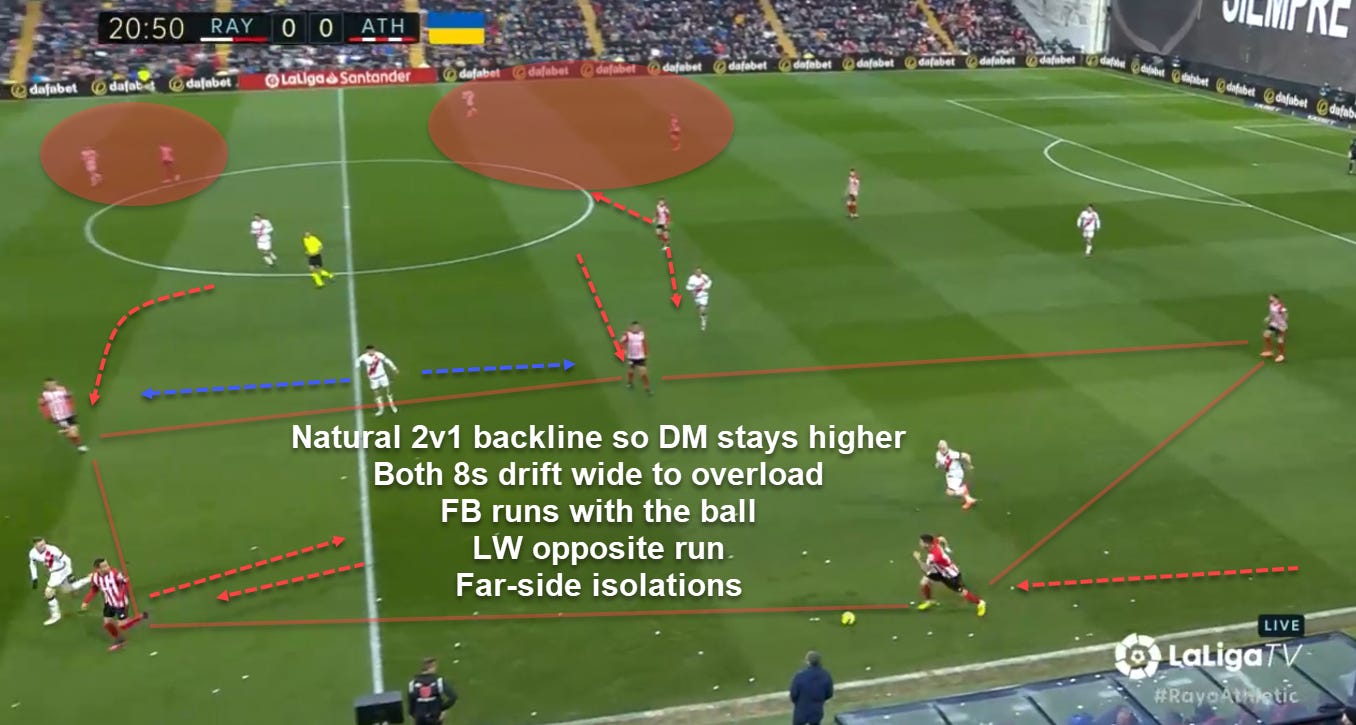
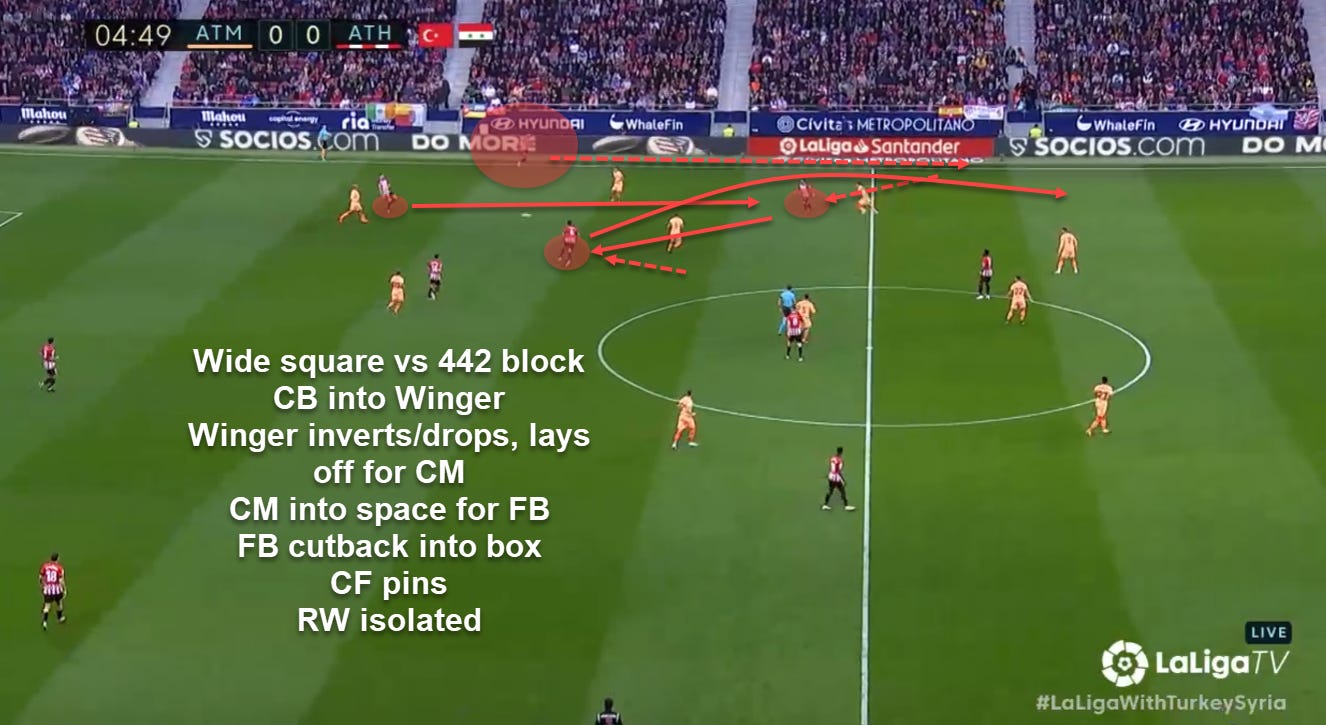
These two examples are good at demonstrating that. We’ve seen them create triangles out wide but they also form squares and even pentagons when needed. Usually, the centre-back will be joined by the full-back, dropping winger and at least one midfielder to complete the overload or simply establish numerical parity. However, as was the case in the first image, adding the fifth player can be used to achieve superiority.
In the second image, we have an example of an excellent combination play. The centre-back finds the dropping winger, the winger lays it off to the midfielder who then completes the third-man and accesses the overlapping full-back. This sort of play is on brand with Valverde’s style of play: quick, direct and with a hint of positional play.
Once in the final third, Athletic Club will rely on crosses and cutbacks, and often they will have at least four people inside the box in addition to the crosser.
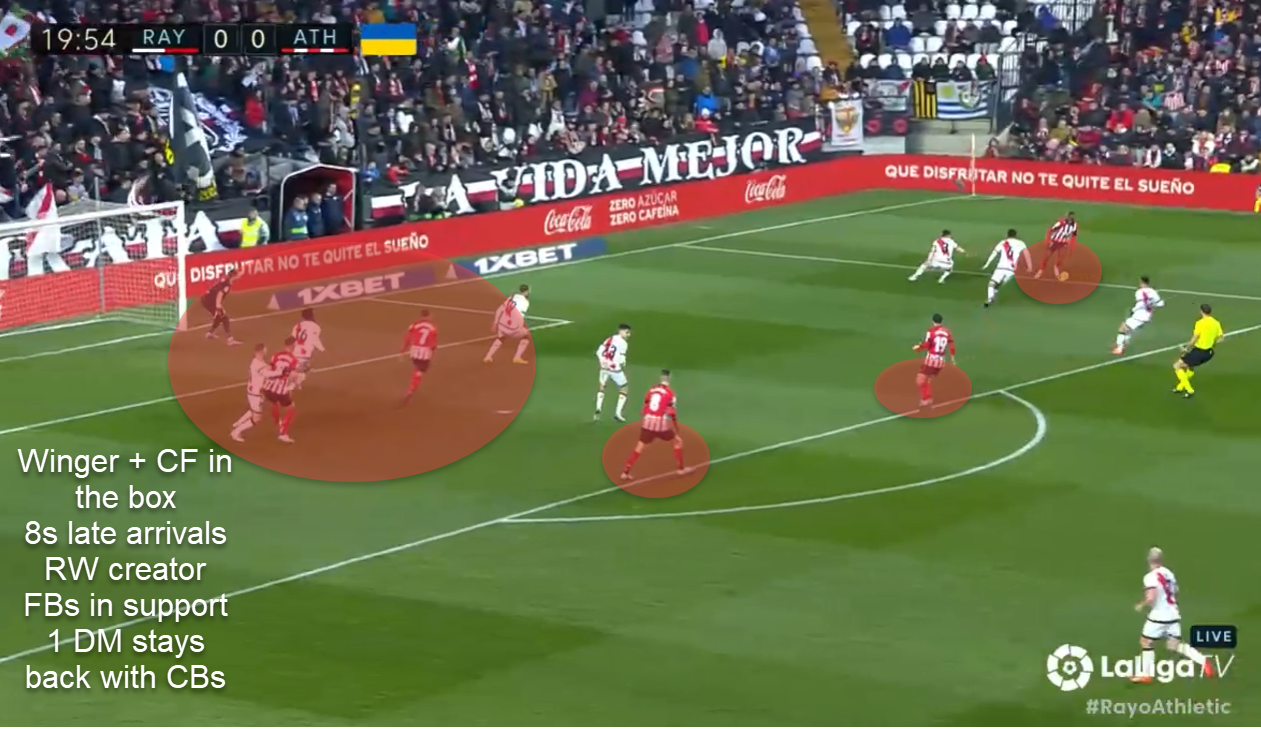
When it comes to key pieces in attack, their biggest weapons come in the form of Nico Williams, Inaki Williams, Alejandro Berenguer, Oihan Sancet and Iker Muniain. Of course, Sancet is suspended and this will hurt them immensely. But it’s possible Valverde opts to start Muniain in his stead as he is an incredible set-piece tool, excellent in build-up and creation and also the most fouled player in the team.
The Williams brothers are the dribblers, high-line exploiters and incredible outlets. They are also the best runners with the ball and can carry it for progression and creation. Both of them get the most touches in the box in the team with Nico also providing deadly deep completions alongside Raul Garcia. He is also a volume crosser and gets the ball into the six-yard box where, interestingly, his brother Inaki has the most headed shots (tied with Garcia).
Garcia himself is an interesting option to consider. Seeing Barcelona will most likely deploy a high line, having someone as Inaki who lives on the shoulder of defenders might be beneficial but Garcia is a good target man, effective in the air, and provides assists and second-assists as well as smart passes.
Still, they don’t have long-range shooters with Sancet absent and have been struggling for goals lately. With Barcelona boasting the best defence in LaLiga, this may pose a serious challenge for the Basques.
Subscribed
Athletic Club off the ball
Similarly to their setup in attack, Athletic Club’s off-the-ball identity is very similar: aggressive and direct. Valverde’s squad are one of the sides that press the most and do it with success, registering 8.73 PPDA and 5.9 challenge intensity, enough for the fifth-lowest in the former category (the lower the better) and sixth-best in the latter.
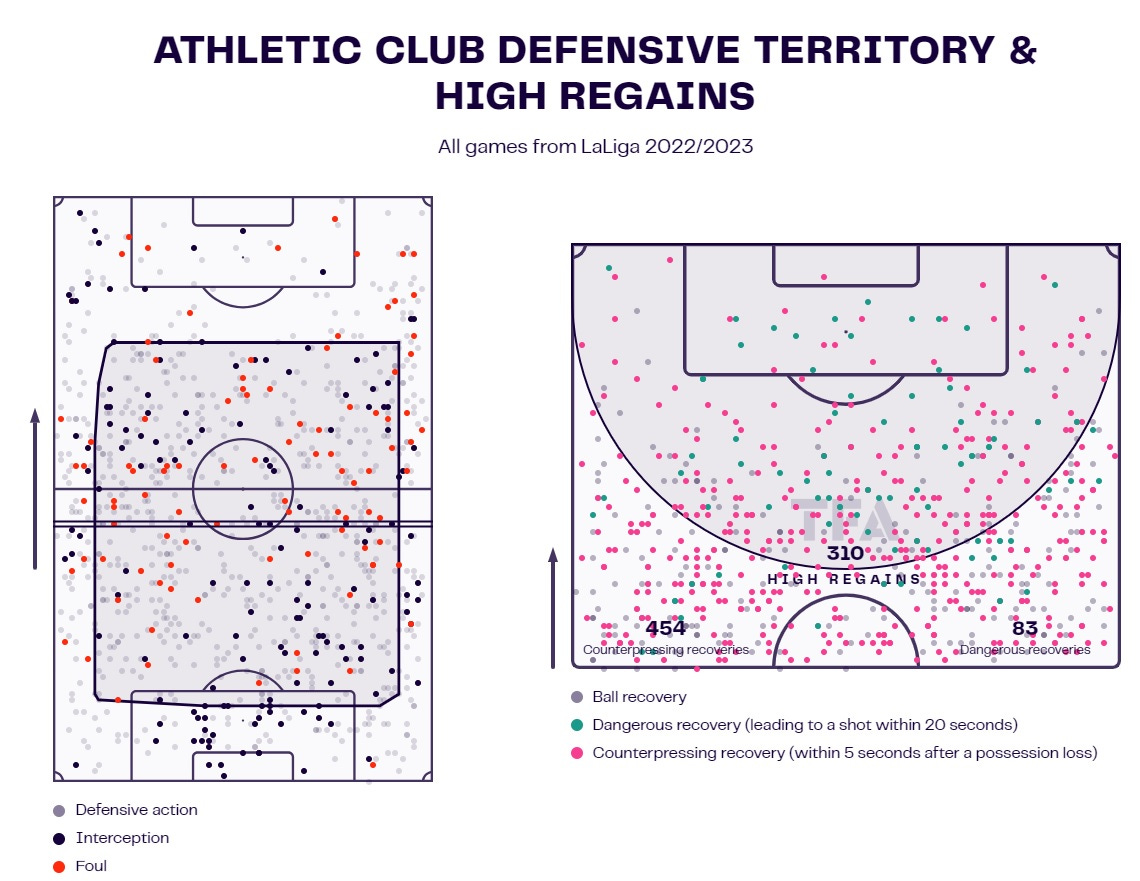
We can see their defensive territory alongside the average height of their defensive line and the high regains in the image above. What immediately stands out is the intensity of their high press. Athletic Club generally set up in an initial 4-2-3-1 mid-block that then morphs as they push up. There are multiple variations of it which include different starting positions depending on the opposition’s setup but usually, it will be a 4-1-4-1/4-5-1 that turns into a 4-4-2 in addition to the aforementioned 4-2-3-1.
When it comes to their pressing orientation, it generally follows a man-marking scheme but is flexible in deeper areas where it becomes a hybrid of zonal and man-marking. An example can be seen below.
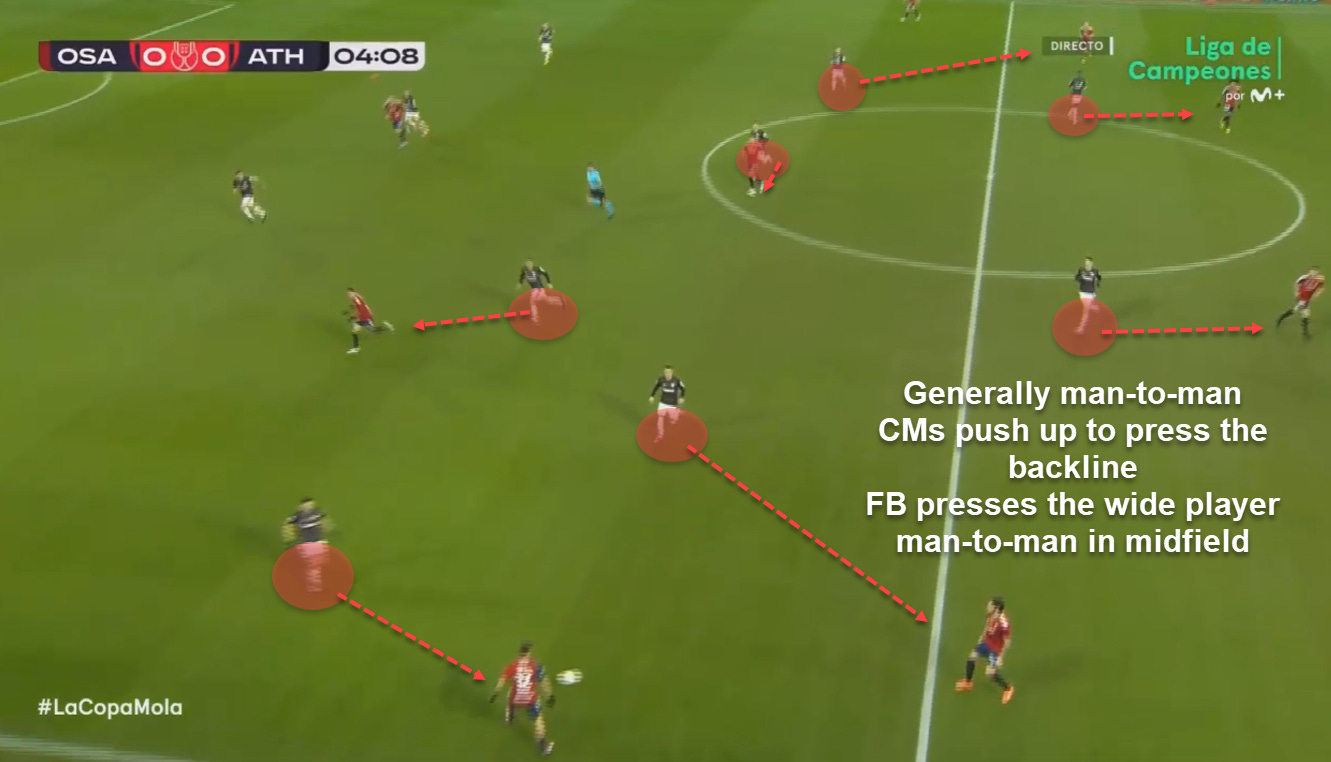
Athletic Club will try and mimic the opposition’s structure, assigning a marker to each of the players, but when and if that player drifts too far away from his marker’s zone, he will become someone else’s responsibility. This does bring a dose of balance into their defensive structure but it also comes with certain drawbacks when not executed well.
In this particular sequence, we see the Basque team push up aggressively to meet their man, morphing the initial structure of 4-2-3-1 to something of a 3-5-2 and eventually 3-4-3. This, of course, is the result of the man-marking which tends to drag players across the pitch.
The aggressive nature, however, lends itself nicely to counter—pressing, which amounts to the large majority of their regained possession in the opposition’s half.
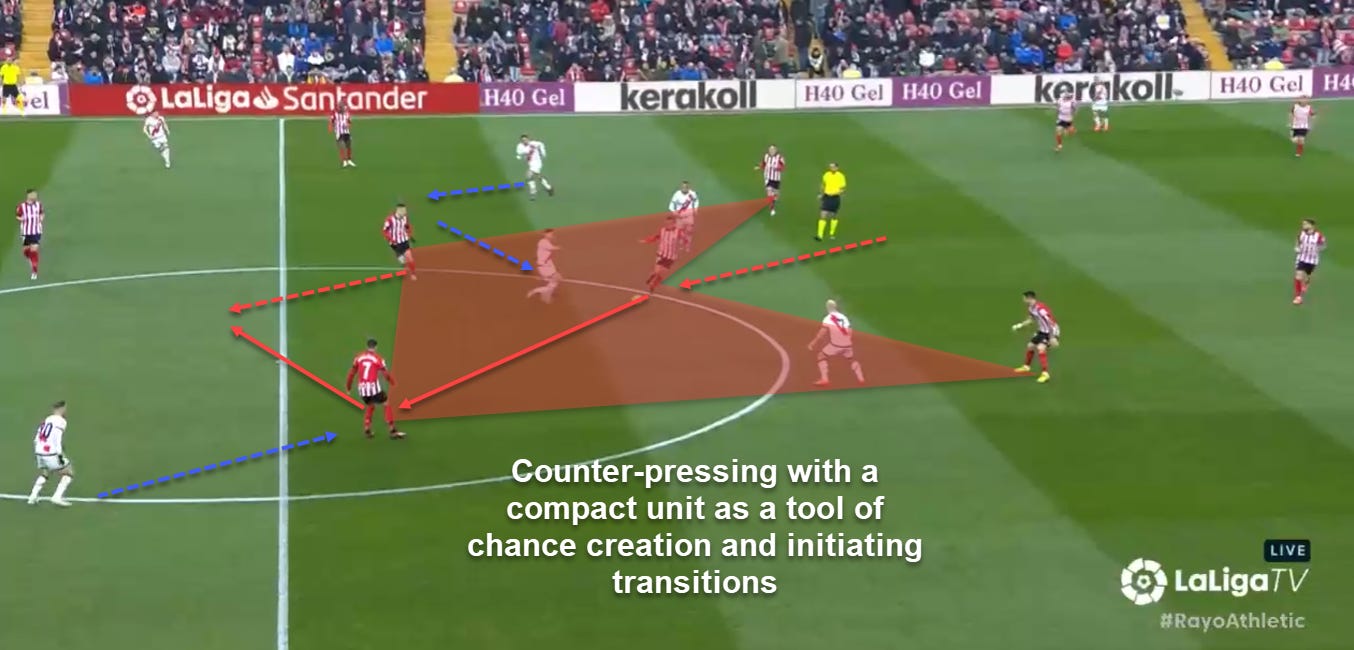
This in itself is both a defensive and offensive tool. Seeing how their team is stacked with runners and brings loads of intensity, each turnover is a new chance to break quickly towards the opposition’s goal. The key to a good counter-press is the compactness of the squad in possession and its rest-defence. In Athletic’s case, both are set up well.
Even though they are geared towards quickly breaking forward, the distances between their players are decreased quickly enough for the counter-pressing to be effective. The rest-defence is generally composed of the centre-backs, one pivot and one (or in some cases two) full-back.
We can see a good sequence of a compact pressing squad in the next two images.
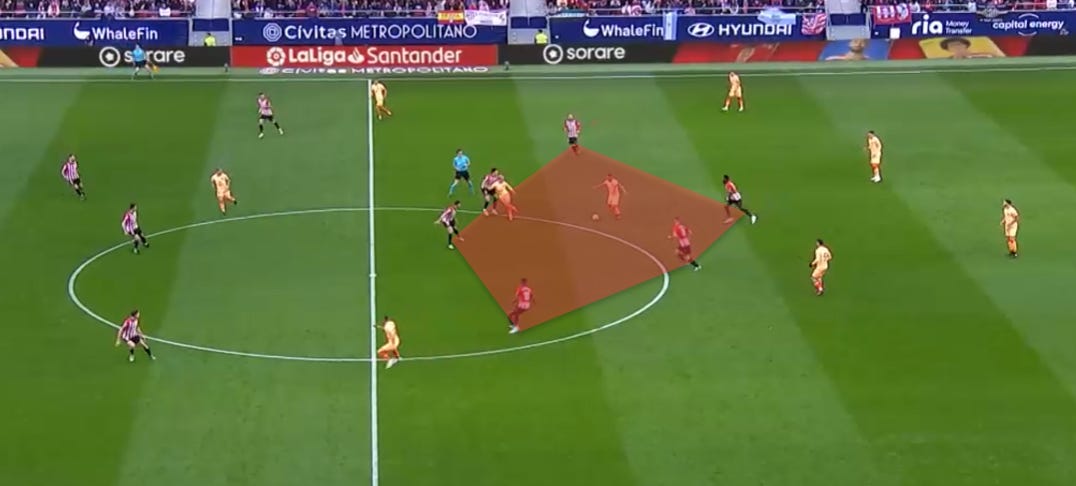
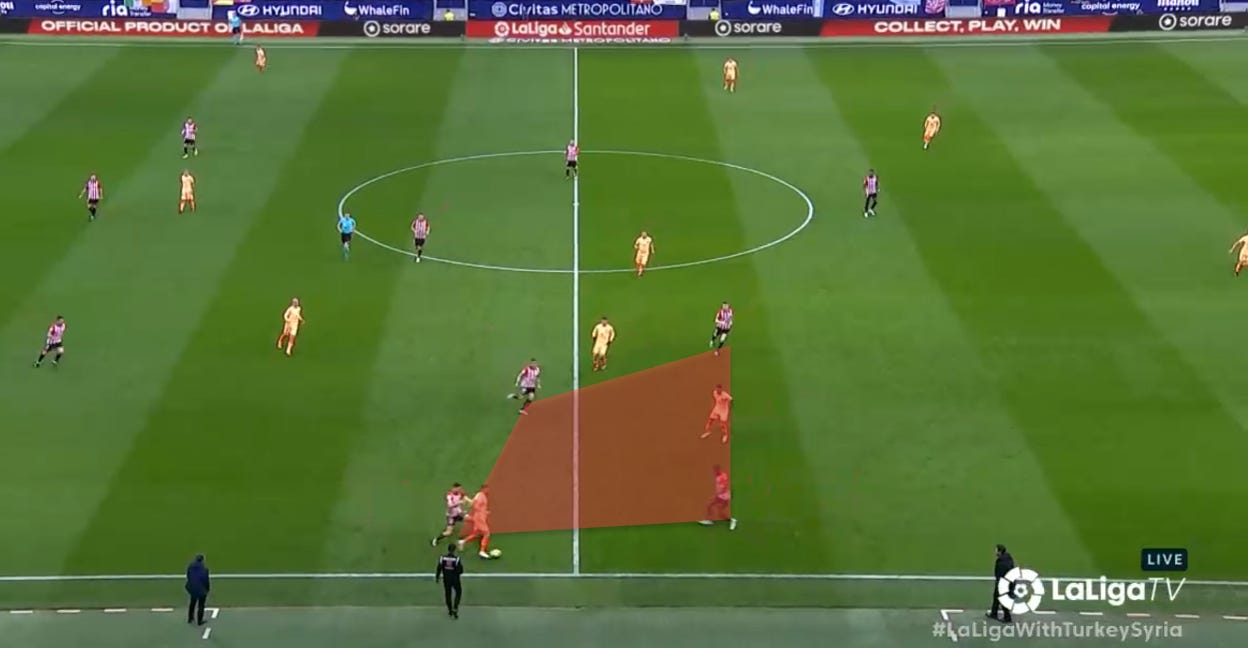
Athletic Club are good at guiding the opponent where they want them to go through their aggression and compactness and here, against Atletico Madrid, it bears fruit. While that may not always be the case, this nature and off-ball behaviour is still a big part of their attacking identity too. As alluded to, counter-pressing isn’t solely a defensive tool; it’s a tool to initiate easier and more effective transitions.
As soon as possession is regained, Athletic Club almost always have at least three outlets to aim for and good delivery experts ready to eject them into space. We talked about the role of centre-backs earlier in the analysis but it isn’t just them. Creative players like Muniain or even the pivots like Vesga and Garcia or full-backs like De Marcos are equipped to connect the thirds quite well in these instances.
Interestingly, the striker position is also of high interest. Athletic Club don’t use highly combinational roles for their 9s so usually, they will either assume the task of a target-man/layoff (Garcia) or a runner (Inaki).
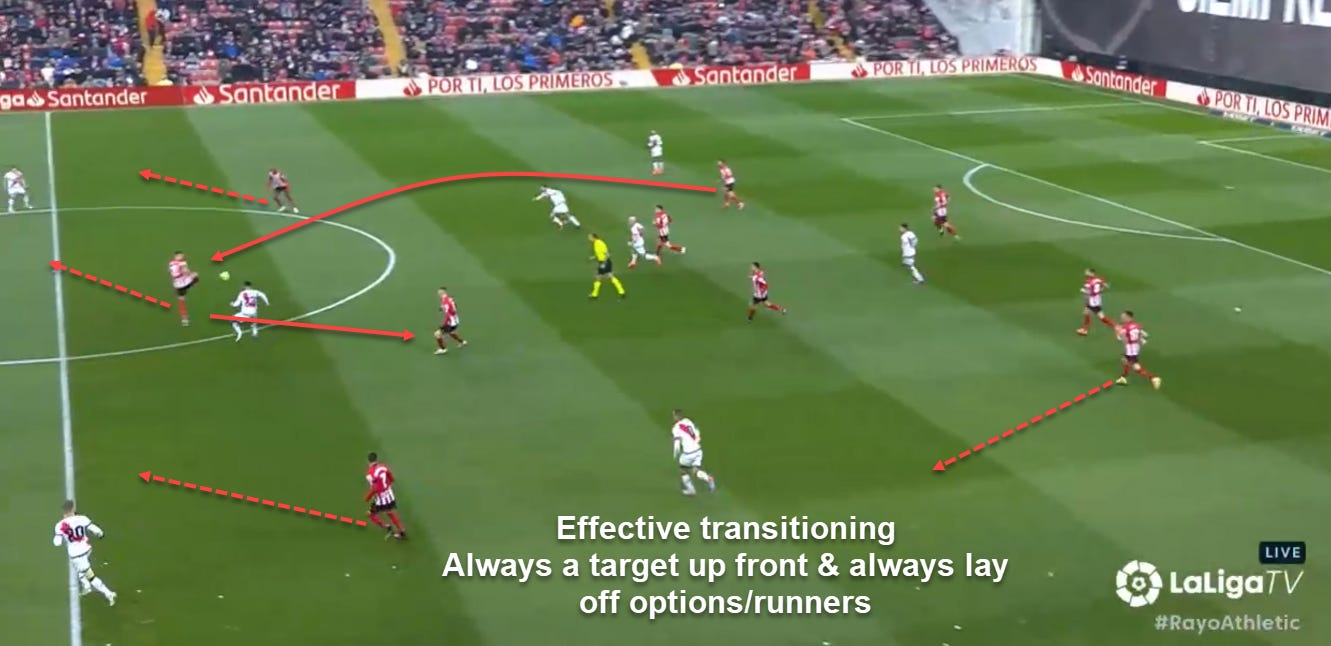
But all of this doesn’t mean their defence is impenetrable. There are certain issues with their timing, sticking to their markers and maintaining compactness between the lines once they start getting dragged across the pitch. We talked about their defensive structure being a hybrid of man-marking and zonal marking and both of these are difficult to execute in their own ways. Man-marking can be unsustainable for the full 90 without losing focus and stamina while zonal marking is a more strenuous mental exercise.
Athletic Club also struggle with the effectiveness of certain players in the team. For instance, Nico and Berenguer despite their great offensive contribution, are often ineffective pressers, allowing the most total and per 90 progressive passes in the league, while the latter also makes the most fouls in the team. This means it’s generally easy for the opposition to bypass them via passing and even if they do get in contact with their rivals, it’s unlikely to yield a turnover.
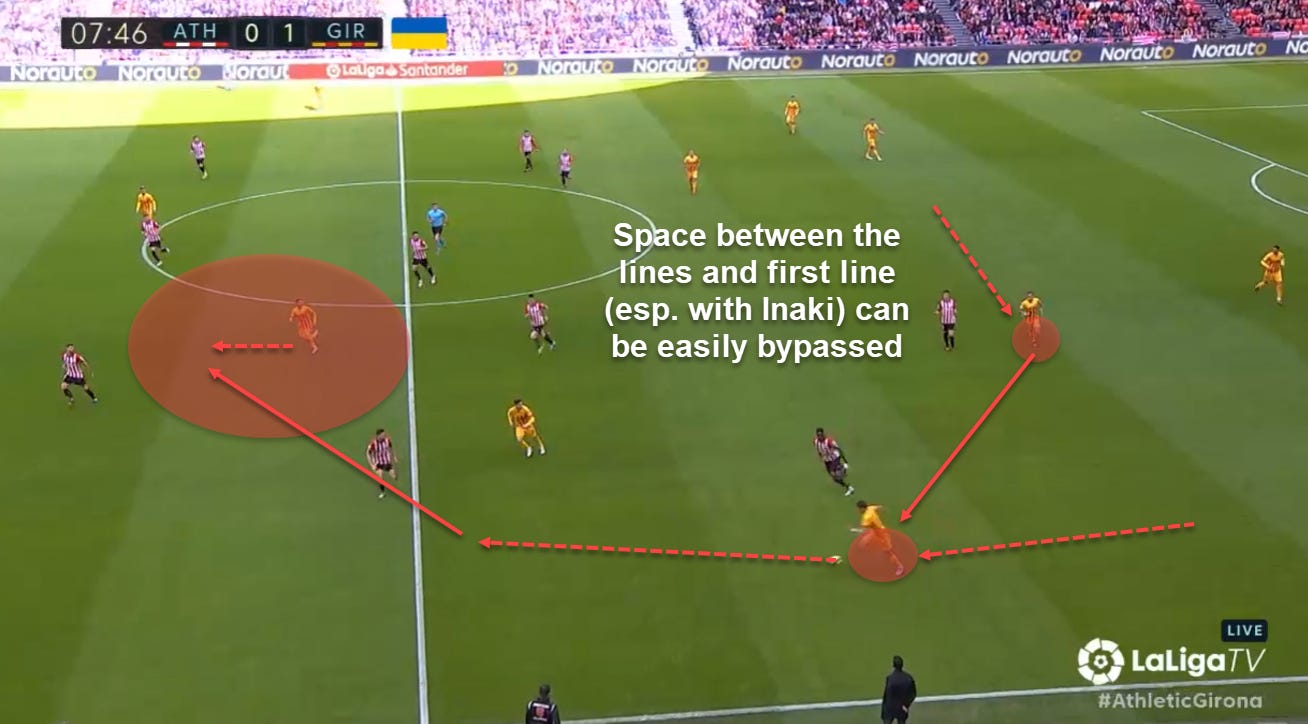
Having an inefficient first line of press can have disastrous consequences too. In this sequence, it’s actually Inaki who allows Girona to easily breeze past him, setting the whole action into motion. This is also a good segue into the issue of lacking compactness between the lines. While they move well as a pressing unit when hunting for the ball, in settled phases they can get moved around themselves by technical opposition.
Leaving markers alone with space and time on the ball is a big flaw, especially for a team that has had such a good defensive record overall. The issues stem from the transformation of their initial 4-2-3-1 structure into its more aggressive variations.
Here are two good examples of that.
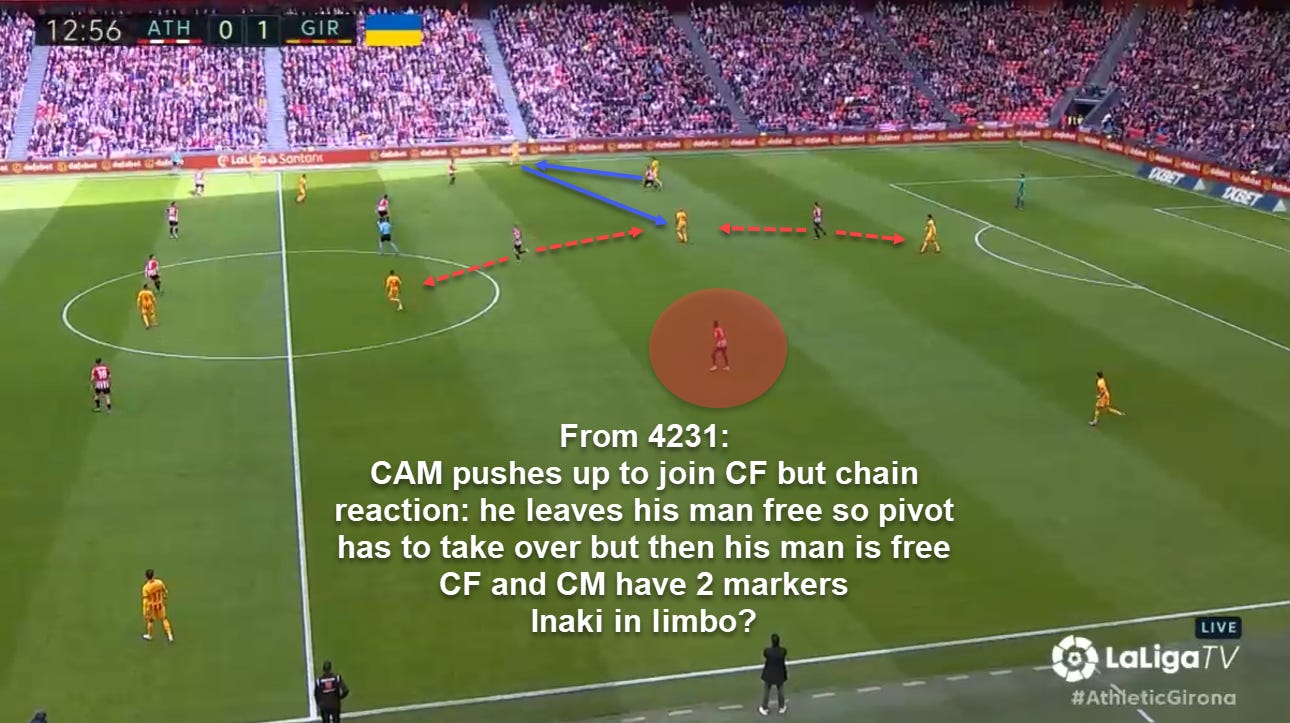
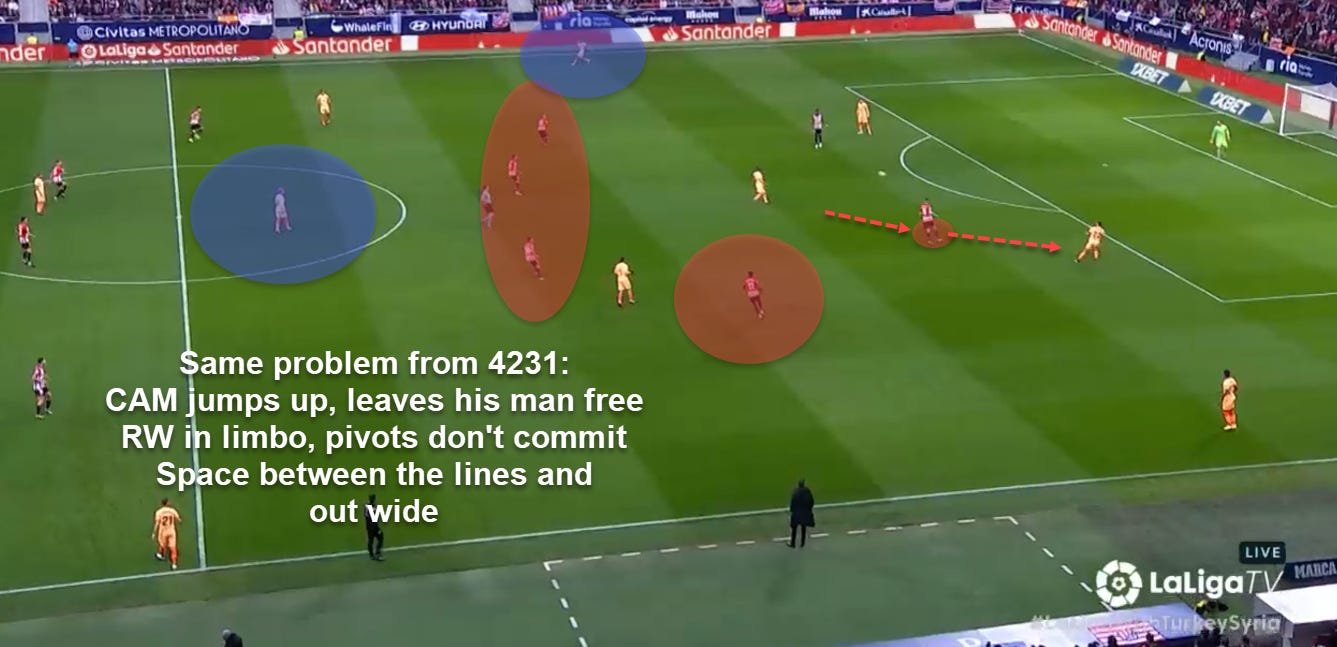
Once the CAM jumps to press from a 4-2-3-1, his teammates immediately need to change markers. The pivot is forced to take the CAM’s previous marker and suddenly, both him and the striker are torn between choosing a target to press. The same is true for the right-winger, who’s caught in a state of limbo in both sequences; he’s not taking over the midfielder’s marker to allow him to push nor is he covering the far-side full-back in case of a switch.
As a result of this confusion, there are acres of space available for the opposition to exploit in both scenarios. It’s quite ironic that a team that started off with such a great defensive record and a team that has the third-fewest shots against in LaLiga is also the team with the second-worst success rate in defensive duels.
Athletic Club’s defensive structure is still solid but a couple of squeaky wheels alongside some mechanical flaws could cause trouble for Valverde’s men when they welcome the Catalan giants at San Mames this Sunday.
Key points:
- In-between a possession and transition side: against better teams, tend to give up possession but against lesser opposition, happy to impose themselves – possession ranges from 63.67% to 37.2% (vs Barcelona!) with an average of 51.06%
- Valverde is pragmatic but also consistent and clear in his ideas. However, that hasn’t always been the case this season
- Mainly stick to the 4231, quite direct going forward but with some good combination play on the wings to eject runners. Usually, winger, FB and ball-side 8 combine higher but deeper can be a square of winger, FB, CB and one CM OR a pentagon of winger, FB, CB and 2 CMs. FBs also quite aggressive but with late runs rather than constant overlaps
- Offensive players to look out for: Nico Williams, Inaki Williams, Alejandro Berenguer, Oihan Sancet and Iker Muniain. Sancet being absent is a huge miss!
- Geared towards counter-attacking and this benefits them vs Barcelona due to the high line and the absence of Araujo (Inaki + Nico into space, Muniain the creator)
- Build-up can be with 2 or 3 (depending on the opposition press, the pivot will drop for superiority) and through the pivot(s) but also quite direct at times – straight into the target man + layoffs OR directly into space for runners if they get time on the ball.
- Nico and Inaki both drop and then burst into space. Full-backs are very involved too but the goal is to keep one free on the opposite end (asymmetrical), especially for the overlap/overloads: often straight from the CBs into the far-side winger
- Nico and Inaki are the only wide wingers, Berenguer and Muniain inverted and dropping despite the occasional initial wide position. The side where there’s a wide winger will have a slightly inverted/deep FB for support (creates a triangle with 8 in the half-space and wide winger and often ejects either into space)
- If both Williams brothers play, Nico drifts inwards (initially high and wide), Inaki drifts to left half-space, Berenguer (LW) hugs the touchline initially, Nico pins CBs, Inaki makes an opposite run into space or vice versa
- Most chance creation stems from the wings (crossing, dribbling and cutbacks), lack goals despite being volume shooters
- Defend in a 4-1-4-1/4-5-1 that turns into a 4-4-2: one CM pushes up but generally stays on the pivot while the CF chases the ball. Pivot can then push up to mark the other pivot while the CM pushes up alongside the CF
- They have issues with timing the press and marker selection
- Generally man-to-man but also zonal (once a player leaves a certain zone, he becomes someone else’s marker) – but they lose markers in their aggression quite often and it can be deadly inside the box
- Compact and aggressive in counter-pressing, which is also a great tool for offensive transitions
- Players who lose duels in defence: Vivian, Berchiche, Nico, Inaki, De Marcos, Dani Garcia, Muniain, Zarraga, Guruzueta, Vesga
- Players who lose aerial duels: Muniain, Nico, Inaki, Berenguer, Zarraga, Guruzueta, Lekue
- Worst tacklers: Vesga, Zarraga, Guruzueta, Inaki, Raul Garcia, Berenguer, Nico, De Marcos
- Lose balls often: Nico, Berenguer, Inaki, De Marcos, Muniain but more importantly, Vesga, Yeray, Berchiche, Vivian
- Most fouls: Vesga, Berenguer, De Marcos, Vivian
- Lowest passing %: Berenguer, Lekue, De Marcos, Berchiche, Vivian

